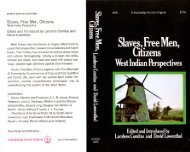e - CIFAS
e - CIFAS
e - CIFAS
You also want an ePaper? Increase the reach of your titles
YUMPU automatically turns print PDFs into web optimized ePapers that Google loves.
80 GOVERNMENT IN ZAZZAU GOVERNMENT IN FULANI ZAZZAU, 1865 8l<br />
2. SOCIETY IN FULANI ZARIA<br />
The population of Fulani Zaria in the last century was partly<br />
slave, partly free. The slaves included captives. few ofwhom were<br />
Muhammadan, butthose born into slavery were reared as Muhammadans.<br />
Free members ofthe society were either freedmen or born<br />
free. Eunuchs must also he distinguished from the slave and the<br />
free, although they suffered many of the legal disabilities of slaves<br />
in Fulani Zaria.<br />
The free population of Fulam Zaria were divided firstly by<br />
religion into Muhammadan and non-Muhammadan groups. Most<br />
of the non-Muhammadans were tribesmen living to the south and<br />
west of the state, and slaves were regularly drawn from these<br />
populations by raids or tribute. Excluding these non-Hauaaspeaking<br />
'pagans', the principal division among the free Muhammadan<br />
population of Zaria was between the Fulani and the Babe,<br />
the conquerors and the conquered. The conquest reflected this<br />
ethnic differentiation and initiated new relations ofsuperordination<br />
and subordination which were established in the process of consolidation.<br />
(a) Rank and Li'lUUlge among the Fulani<br />
The Fulani of Zaria were divided into Settled and Nomadic<br />
groups. The Settled Fulani ruled the state, intermarrying with<br />
their Nomadic cousins, who also assisted occasionally in raids and<br />
war. The Settled Fulani were internally divided into a number of<br />
lineages, and these were strati6ed according to their position within<br />
the system of government. There were four dynasties at Fulani<br />
Zaria, the Mallawa, Bornawa, Katsinawa, and Suleibawa. Of these<br />
the 6rst three were the most important politically, and had the<br />
largest membership. In addition, there were a nwnber of other<br />
aristocratic Fulani patrilineages, such as the Katsinawa 'Yan Doto,<br />
the 'Van Doto of Gusau, the Fulanin Wunti, Fulanin Yesqua,<br />
Fulanin JoIi, Fulanin Gadidi, and the Fulani of Dan Durori; certain<br />
other patrilineages such as the Fulanin Bebeji, or the Fulanin<br />
Shanooo were of Kano origin; the Toronkawa Fulani were<br />
descended from Waziri Gidado of Sokoto by the daughter of M.<br />
Musa, the baMalle conqueror; and there were also Fulani from<br />
various parts of Katsina such as Damfa, the Dokaje, and others.<br />
The aristocratic status enjoyed by these Iineages was related to<br />
their political roles in two ways. Aristocratic status qualified them<br />
for political roles and office. It was further established through<br />
and enforced by participation in government. This list of noble<br />
Fulani lineages reflects in part the heterogeneous composition of<br />
the Fulani force which invaded Zaria under Musa; but it also includes<br />
some Fulani who were already settled in Zaria at that date.<br />
The status of the ruling lineages was superior to that of other<br />
Fulani in Zaria. Members ofthese dynasties were royals by birth.<br />
Their male members were each a yerima (prince), their females, a<br />
gimbiya (princess). Such persons paid no land-tax (kurdin kasal,<br />
and were also exempt from other annual taxation under the rule of<br />
hurumi, or perpetual exemption, a right which vested in these<br />
dynasties by virtue of their royal status.<br />
The other aristocratic Fulani lineages of Zaria were also·internally<br />
differentiated through their competition for political office.<br />
Successful lineages tended to have higher status and greater wealth<br />
than their less successful competitors. Such differentiation was itself<br />
a ground for the allocation of office, while the allocation of<br />
office further increased these differences. Office provided its<br />
holders with opportunities for the accumulation of wealth, booty,<br />
and slaves, and slaves were the main sources of farm labour. An<br />
owner having sufficient slaves utIually established his own settlement.<br />
This was called a rinji (slave-village or hamlet, pI. rumada;<br />
alternatives keffi,1 tunga). The number and size of the rumada<br />
which a person or family controlled was evidence of the owner's<br />
wealth and power. Merchants and many other non-officials had<br />
slaves, but permission was necessary in order to build separate<br />
settlements for TUNlOda, and this was generally given only to the<br />
nobility. In Zaria, the majority of the larger rumada belonged to<br />
one or other of the dynasties. These rumada were the principal<br />
fonDS of capital investment in Zaria, and thus political status was<br />
closely related to the distribution of wealth; conversely, the distribution<br />
of wealth was related to the distribution of political office.<br />
The relations between noble status, political office, and wealth<br />
tended to be circular, in the sense that each of these factors reinforced<br />
the other. However, this circle was neither closed nor<br />
complete for the following reasons.<br />
Firstly, conunoners were never completely excluded from<br />
1 The southern vaesaJ. state called by this name was often regarded as a IIlave<br />
reserve.





